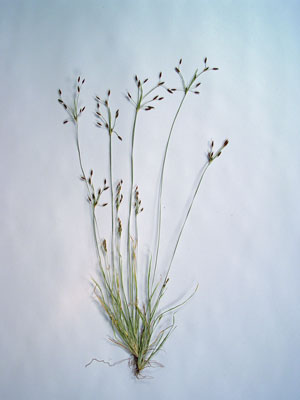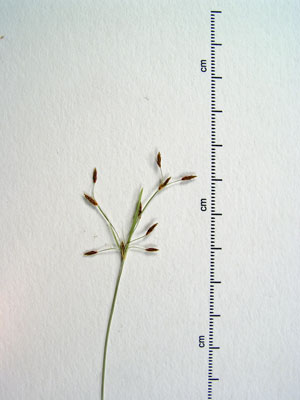DACF Home → Bureaus & Programs → Maine Natural Areas Program → Communities, Plants, and Animals → Rare Plants → Fimbristylis autumnalis

Fimbristylis autumnalis (L.) Roemer & J.A. Schultes
Fall Fimbry
- State Rank: S2S3
- Global Rank: G5
- State Status: Special Concern
Habitat: Sandy or peaty shores and low ground. [Open wetland, not coastal nor rivershore (non-forested, wetland)].
Range: Georgia to Louisiana, north to central Maine, southwest Quebec and southern Ontario. Also listed as rare in Vermont, but not elsewhere in New England.
Aids to Identification: This tiny sedge is easily overlooked. It grows in clusters or mats of plants 5-8 cm tall. Leaves are thread-like. The fruiting heads (spikes) are small (3-7 mm long) and egg-shaped and borne in clusters atop the short stems. Fimbristylis could be confused with small individuals of the related Bulbostylis capillaris; Fimbristylis autumnalis has flat stems and the larger leaves are wider than 1.0 mm, while Bulbostylis capillaris has capillary stems and leaves narrower than 0.5 mm. Also superficially similar is the tiny sedge Lipocarpha micrantha (very rare in Maine), which differs in having a leaf-like bract continuing above the spikes so that the spikes look like they emerge from the side of the stem.

Ecological characteristics: In Maine, Fimbristylis grows in sandy wet soils of pondshores where the water level drops over the summer (Outwash Plain Pondshores). It is typically found growing beneath the canopy of other herbaceous plants such as Juncus pelocarpus, Dulichium arundinaceum, and Euthamia tenuifolia (formerly Solidago tenuifolia). It is not known to occur in shrubby or wooded parts of wetlands.
Phenology: Flowers August - October; fruits September - October.
Family: Cyperaceae
Synonyms: Fimbristylis autumnalis (L.) Roemer & J.A. Schultes var. mucronulata (Michx.) Fern.; Scirpus autumnalis L.
Known Distribution in Maine: This rare plant has been documented from a total of 22 town(s) in the following county(ies): Androscoggin, Cumberland, Franklin, Kennebec, Oxford, Penobscot, Sagadahoc, Waldo, York.
Reason(s) for rarity: Near northern limit of range, and Outwash Plain Pondshore habitat naturally scarce.
Conservation considerations: Heavy all-terrain vehicle use of the sandy habitats where this occurs has degraded the habitat in some locations and continued use will be detrimental to the plant populations.